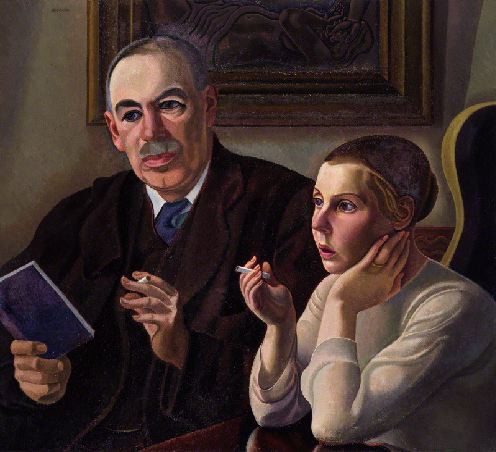AN ENGLISH CUBIST
WILLIAM ROBERTS:
John Maynard Keynes and Lydia Lopokova
Illustration © The Estate of John David Roberts. Catalogue information based on the catalogue raisonné by David Cleall. For this and full details of the exhibitions cited, see the links below. Any auction prices quoted may not include all fees and taxes, such as VAT and Artist's Resale Right charges.

John Maynard Keynes and Lydia Lopokova, 1932
Oil on canvas, 72.4 cm x 81.6 cm
Keynes (1883–1946) was born in Cambridge and educated at Eton and at King's College, Cambridge. After a spell at the India Office and teaching economics at Cambridge, he was recruited to the Treasury. After the First World War he was involved in drafting the financial clauses of the peace treaty, but resigned in May 1919 and began writing The Economic Consequences of the Peace (published that December), which urged the benefits of imposing less onerous reparations on Germany. Other major works included A Tract on Monetary Reform (1923), A Treatise on Money (1930) and The General Theory of Employment, Interest and Money (1936). Encouraged by his friends in the Bloomsbury Group, he was actively interested in the visual arts since 1914, and at the sale of Degas's collection in Paris in March 1918 he bought works by modern French artists both for himself and on behalf of the National Gallery. In 1925, with Samuel Courtauld and others, he set up the London Artists' Association to provide financial assistance to chosen artists, among whom, from 1927, was Roberts. Keynes wrote that Roberts was a painter whose work 'will really live' (to collector and textile millionaire Frank Hindley Smith, 27 Oct. 1933; quoted in Robert Skidelsky, John Maynard Keynes, vol. 2 (London: Macmillan, 1992), p. 527), and he eventually owned 14 works by Roberts – more than by any other artist except Duncan Grant. (For Roberts's views on the LAA and Keynes's patronage, see his essay 'Dealers and Galleries'.)
Lydia Lopokova, whom Keynes married in 1925, had appeared in London with Diaghilev's Ballets Russes in 1918, when Keynes was not impressed, commenting 'She's a rotten dancer – she has such a stiff bottom' (Skidelsky, op. cit., p. 93). But when, towards the end of 1921, he saw her again in other roles for Diaghilev, including the princess in The Sleeping Beauty, he fell deeply in love with her, but before they could marry her marriage to Diaghilev's former business manager Randolfo Barocchi had to be annulled. She later danced in productions of the Camargo Society, for which Roberts designed a backcloth.
The double portrait may have been commissioned in 1930, but was paid for (£50) on 4 July 1932. Roberts had written to Keynes on 25 June 1932 for permission to include it in the LAA exhibition which opened on 29 June: 'I had told Davidson . . . I thought it would be available. As however there is still some more to be done to the head of your wife she may not wish to have the canvas shown until everything is finished' – Cambridge 1983 catalogue.
PROVENANCE: Maynard Keynes > King's College, Cambridge > National Portrait Gallery (NPG 5587, 1983)
EXHIBITION HISTORY: London Artists' Association 1932 ('Roberts is nothing if not a mannerist, but his hard, linear style is here modified in the interests of direct representation. He certainly has not flattered either in features or apparel the distinguished economist and the exquisite ballet dancer, the subjects of this group. There is a mechanical, unsympathetic quality in Roberts's line; but he is an able portraitist … and in this case his disposition of the half-length figures within his picture-area gives a most attractive decorative character to the portrait' – The Scotsman, 11 July 1932; '[T]he other picture [which attracts immediate attention] is the sedate and compact portrait of "Mr. and Mrs. J. M. Keynes" (No. 9), into the linear and chromatic arrangement of which Mr. William Roberts seems to have poured all his science and love of harmonious organisation and fundamental solidity. As a pictorial composition it has the dignified countenance of an old master; as a portrait, in spite of the very perfect rendering of the sitters' features, it is deficient in human characterisation. The expressionless eyes with their empty, fixed, look, the unlit cigarettes held between exaggeratedly stylised liana-like fingers – (has Mr. Roberts lately been closely looking at Uccello?) – contribute to the solidarity of the composition, but also give the sitters the appearance of lifeless, mechanical dolls. Still, it is a fine piece of painting and one of the most consistent and accomplished works Mr. Roberts has ever produced' – P. G. Konody, The Observer, 17 July 1932), Eastbourne 1953, Stockport 1954, Cambridge 1983, National Portrait Gallery 2000, Ghent 2007
Home page | Chronology | Bibliography | Collections | Exhibitions
News | Gallery | Auction results | The artist’s house | Contact
List of works illustrated on the site
Catalogue raisonné:
chronological | alphabetical